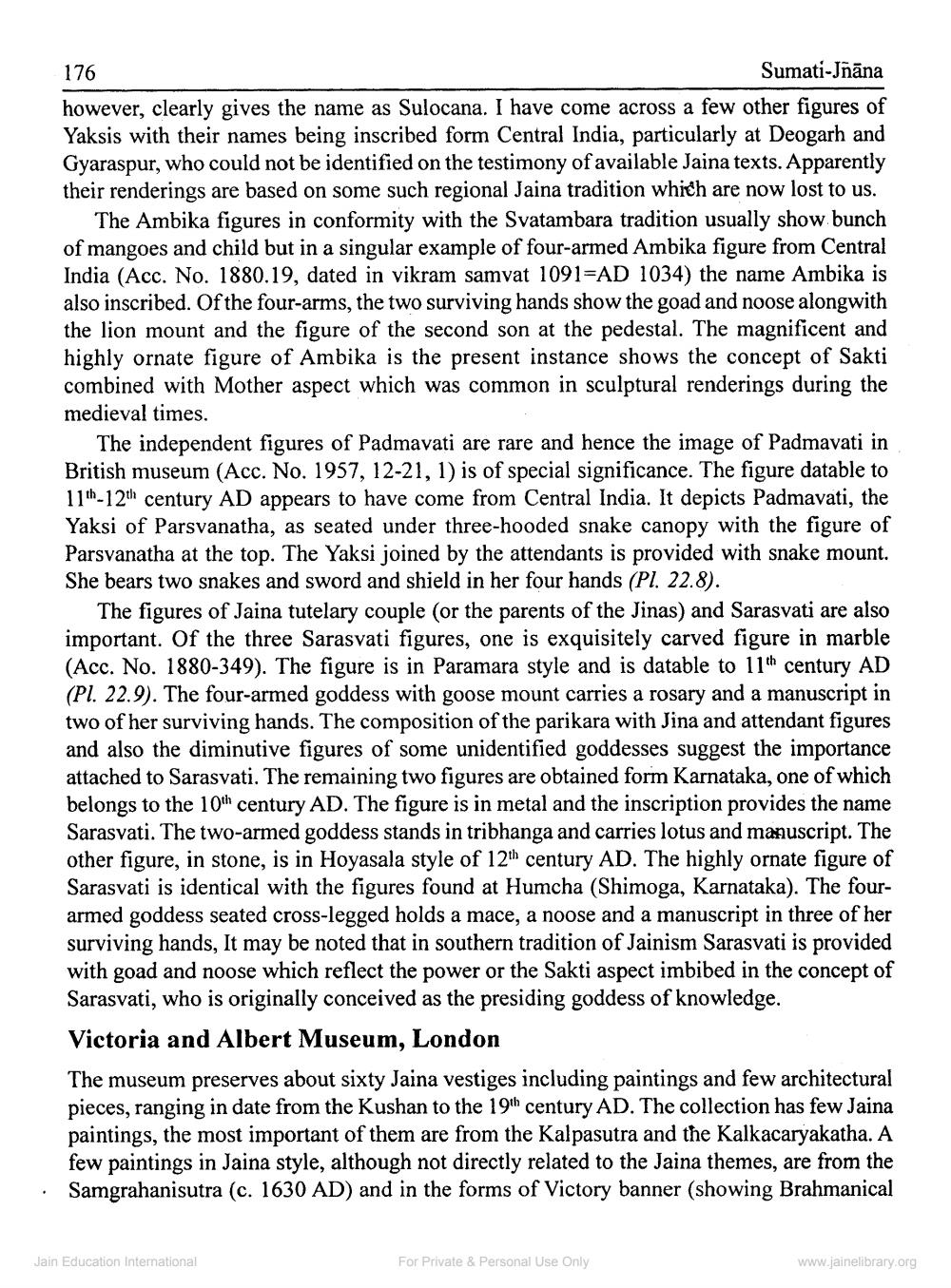________________
176
Sumati-Jñāna however, clearly gives the name as Sulocana. I have come across a few other figures of Yaksis with their names being inscribed form Central India, particularly at Deogarh and Gyaraspur, who could not be identified on the testimony of available Jaina texts. Apparently their renderings are based on some such regional Jaina tradition which are now lost to us.
The Ambika figures in conformity with the Svatambara tradition usually show bunch of mangoes and child but in a singular example of four-armed Ambika figure from Central India (Acc. No. 1880.19, dated in vikram samvat 1091=AD 1034) the name Ambika is also inscribed. Of the four-arms, the two surviving hands show the goad and noose alongwith the lion mount and the figure of the second son at the pedestal. The magnificent and highly ornate figure of Ambika is the present instance shows the concept of Sakti combined with Mother aspect which was common in sculptural renderings during the medieval times.
The independent figures of Padmavati are rare and hence the image of Padmavati in British museum (Acc. No. 1957, 12-21, 1) is of special significance. The figure datable to 11th-12th century AD appears to have come from Central India. It depicts Padmavati, the Yaksi of Parsvanatha, as seated under three-hooded snake canopy with the figure of Parsvanatha at the top. The Yaksi joined by the attendants is provided with snake mount. She bears two snakes and sword and shield in her four hands (Pl. 22.8).
The figures of Jaina tutelary couple (or the parents of the Jinas) and Sarasvati are also important. Of the three Sarasvati figures, one is exquisitely carved figure in marble (Acc. No. 1880-349). The figure is in Paramara style and is datable to 11th century AD (Pl. 22.9). The four-armed goddess with goose mount carries a rosary and a manuscript in two of her surviving hands. The composition of the parikara with Jina and attendant figures and also the diminutive figures of some unidentified goddesses suggest the importance attached to Sarasvati. The remaining two figures are obtained form Karnataka, one of which belongs to the 10th century AD. The figure is in metal and the inscription provides the name Sarasvati. The two-armed goddess stands in tribhanga and carries lotus and manuscript. The other figure, in stone, is in Hoyasala style of 12th century AD. The highly ornate figure of Sarasvati is identical with the figures found at Humcha (Shimoga, Karnataka). The fourarmed goddess seated cross-legged holds a mace, a noose and a manuscript in three of her surviving hands, It may be noted that in southern tradition of Jainism Sarasvati is provided with goad and noose which reflect the power or the Sakti aspect imbibed in the concept of Sarasvati, who is originally conceived as the presiding goddess of knowledge. Victoria and Albert Museum, London The museum preserves about sixty Jaina vestiges including paintings and few architectural pieces, ranging in date from the Kushan to the 19th century AD. The collection has few Jaina paintings, the most important of them are from the Kalpasutra and the Kalkacaryakatha. A few paintings in Jaina style, although not directly related to the Jaina themes, are from the Samgrahanisutra (c. 1630 AD) and in the forms of Victory banner (showing Brahmanical
Jain Education International
For Private & Personal Use Only
www.jainelibrary.org




